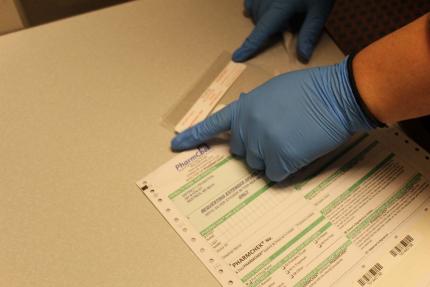Drug Testing During the Pandemic
The Covid-19 pandemic has brought about a variety of recent changes for the Nebraska Probation System. Staff have quickly adjusted and learned to do business differently in order to maintain client contact, compliance with court orders and community safety. One of those adjustments has been modifying traditional approaches to drug testing to ensure operations continue safely and effectively. For many, this has included increased usage of the sweat patch method, which has allowed for greater social distancing while testing.
Worn on the skin, the sweat patch is a collection device that detects the presence of drug molecules in perspiration and retains evidence of drug use for an extended period. The sweat patch is coated with an outer layer of a polyurethane film and an adhesive that helps keep the patch sealed on the skin for up to two weeks. While the average wear time is seven to ten days, enough sweat can be absorbed into the pad to receive certified laboratory results after just one day. By design, any attempts to tamper with or contaminate the test are usually very noticeable and can be promptly addressed by the supervising officer.
Normal activities such as bathing, showering, and working out are all permitted while wearing the patch. Not only is less contact required, but day-to-day routines for probation and problem-solving court participants are also minimally impacted. Katheryn McAhon, Drug Technician for District 1 Probation, said that the sweat patch applications have been going well. “One client is a new mom with a new baby and she really appreciates not having to come in frequently to leave a specimen sample as she would need to bring her new baby along, exposing both of them to the public during this pandemic. This way, I can apply the sweat patch for her and she can come in seven to ten days later.” Compliance with the drug testing order is also supported through ongoing communication and case management by the supervising officer.
In addition to the variable removal date, advantages of using the sweat patch technology include an increased window of detection, a less intrusive collection process, and quick application and removal. Renee Faber, Supportive Service Specialist, for the Administrative Office of the Courts and Probation, oversees drug testing throughout the state and facilitated training efforts for this technique. Faber explained that, “unlike urine testing, both the parent drug and the drug metabolite can usually be detected in sweat, which increases the likelihood of confirming a positive result.” The laboratory used for analysis also adheres to specific cutoff levels for detection, which eliminates the possibility of environmental contamination.
The Food and Drug Administration approved the sweat patch for use as a drug-testing device on October 4, 1990, and this method is widely utilized throughout the justice system. Use of the PharmChek® sweat patch has been upheld as a valid and reliable testing methodology in over 50 state and federal courts, including the 8th Circuit Court of Appeals, by The Honorable Sandra Day O'Connor, Associate Justice of the United States Supreme Court, (Ret.), sitting by designation, pursuant to 28 U.S.C. § 294(a). While a number of testing methods are available to the field, the sweat patch testing method has proven to be a very helpful tool in promoting social distancing while also holding individuals accountable to their court orders during the current pandemic.
Top Photo: Katheryn McAhon, Drug Technician for District 1 Probation, applies a sweat patch for testing.
Bottom Photo: Each sweat patch test submitted to the laboratory is clearly identified with a bar code and serial number. Once the specimen is obtained, it is placed in a clear plastic bag and sealed shut to protect the chain of custody while in transit to the lab for testing.

